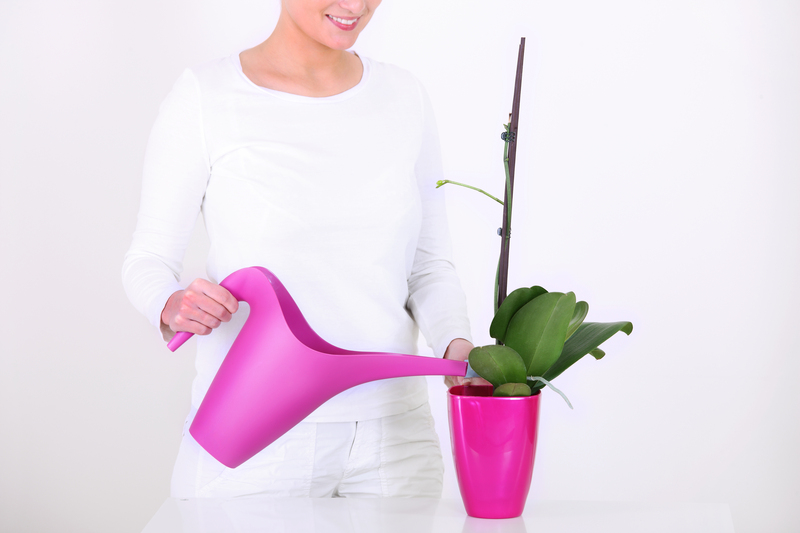The Essential Guide to Healthy Orchids
Posted on 26/05/2025
The Essential Guide to Healthy Orchids
Orchids are renowned for their stunning beauty and unique shapes, captivating both beginners and expert gardeners. However, these exotic plants need more than admiration to flourish. Understanding the essentials of orchid care is vital for anyone wishing to cultivate vigorous, blooming orchids year-round. In this comprehensive guide, we'll walk through everything you need to know for growing healthy orchids at home. From selecting the right species to mastering watering techniques, you'll find practical advice to ensure your orchids thrive.
Why Orchids Are Special: Understanding Healthy Orchid Growth
With over 25,000 species, orchids represent one of the largest and most diverse flowering plant families. They are known for:
- Stunning flower structures with unparalleled variations in color and shape
- Resilience and adaptability to a variety of growing conditions
- Unique root and leaf systems that set them apart from other houseplants
Successful orchid care begins with an understanding of these special characteristics, forming the foundation for healthy orchid cultivation.

Choosing the Right Orchid Species for Your Home
Not all orchids are created equal. Some species are easier for beginners, while others cater to advanced hobbyists. Here are top options to consider:
Popular & Beginner-Friendly Orchid Species
- Phalaenopsis (Moth Orchid): Known for its beautiful, long-lasting blooms, and ease of care.
- Dendrobium: Offers a wide range of flower colors and shapes; thrives in moderate humidity.
- Cattleya: Famous for its strikingly vivid and fragrant flowers; prefers brighter light.
- Oncidium (Dancing Lady Orchid): Perfect for enthusiasts looking for abundant, golden flowers.
- Paphiopedilum (Lady Slipper): Unique pouch-like labellum and suitable for windowsills.
Choosing an orchid species that fits your environment and skill level is the first step towards long-lasting healthy orchids.
Understanding Orchid Needs: Light, Water, Humidity, and Temperature
To grow healthy orchids, you must master four critical factors:
- Light
- Watering
- Humidity
- Temperature
Orchid Light Requirements
Most orchids thrive on bright, indirect sunlight. Too much sun can scorch leaves, while too little inhibits blooming.
- Phalaenopsis: Medium, filtered light (north or east-facing window).
- Cattleya & Dendrobium: Require more light (south or west-facing window with sheer curtain).
- Oncidium: High light but should be protected from intense midday sun.
*Tip: Healthy orchid leaves should be bright green, never deep green (too little light) or yellow (too much light).
Watering Orchids Correctly
Improper watering is the number one reason orchids become unhealthy. Follow these guidelines:
- Allow the potting medium to dry slightly between waterings--do not let orchids sit in soggy soil.
- Water early in the day for optimal absorption.
- Use tepid or room temperature water; avoid using softened or distilled water.
- Most orchids need water once a week; adjust frequency based on climate and potting medium.
*Signs of overwatering include limp, yellowing leaves and mushy roots.
Humidity for Healthy Orchid Growth
Orchids are epiphytes, meaning they naturally absorb moisture from the air. Maintain humidity between 40% and 60% for best results.
- Use a humidity tray or room humidifier during dry months.
- Mist foliage lightly--but make sure water does not pool in leaf axils to avoid rot.
Temperature Needs of Orchids
Orchids generally prefer these temperature ranges:
- Day: 18?C - 29?C (65?F - 85?F)
- Night: 13?C - 18?C (55?F - 65?F)
Keep orchids away from cold drafts, air-conditioning vents, or heaters.
Choosing the Right Potting Medium for Strong Orchid Roots
Orchid roots need air as much as they need water! Poor drainage causes root rot, a common issue in unhealthy orchids. The best orchid potting mediums include:
- Bark chips
- Moss (sphagnum or peat moss)
- Perlite or pumice
- Chunks of charcoal
- Coconut husk chips
A mix of two or three of these is ideal. Repot orchids every 1-2 years to provide fresh medium and check root health.
Fertilizing for Vibrant, Healthy Orchids
Feeding orchids properly encourages lush foliage and profuse blooms. Use a balanced orchid fertilizer (20-20-20) at half strength:
- Fertilize once per month during active growth phases.
- Flush the pot with plain water occasionally to prevent salt buildup.
- Reduce feeding in winter or when orchids are dormant.
Avoid over-fertilizing, which can damage delicate root systems and reduce flowering.
Proper Pruning and Maintenance Techniques
Maintaining healthy orchids requires occasional pruning and cleaning:
- Remove dead or yellowing leaves with sterilized scissors.
- Trim spent flower spikes (unless reblooming is expected, e.g., on Phalaenopsis, cut above a node).
- Clean leaves gently with a damp cloth to remove dust.
Supporting Orchid Blooms
- Staking: Use orchid stakes or clips to support tall flower spikes, preventing them from bending or breaking.
- Rotation: Turn the orchid occasionally for even light exposure and uniform growth.
Repotting: When and How for Happy Orchid Roots
Repotting orchids every 1-2 years ensures healthy root systems and vibrant growth:
- Repot in spring or just after flowering.
- Gently remove old medium and cut away any rotten or dead roots.
- Use a new, clean orchid pot with ample drainage holes.
- Fill with fresh, moistened potting mix.
*Tip: Roots growing outside the pot, known as "aerial roots," are normal. Leave these intact as they help with nutrient absorption.
Common Orchid Problems and How to Solve Them
Even healthy orchids can occasionally suffer from pests and diseases. The most frequent issues include:
Pest Infestations
- Spider Mites: Indicated by webbing and tiny dots on leaves. Increase humidity and wipe leaves with insecticidal soap.
- Scale Insects: Brown bumps on stems and leaves. Remove manually and treat with horticultural oil.
- Mealybugs: White, cottony pests. Dab with isopropyl alcohol using a cotton swab and repeat weekly.
Fungal and Bacterial Diseases
- Leaf Spot: Black or brown spots due to overwatering or poor air movement. Remove infected leaves and adjust care.
- Root Rot: Mushy, dark roots from soggy conditions. Repot in fresh medium and reduce watering.
- Bacterial Soft Rot: Foul-smelling, watery rot. Remove affected parts and ensure better ventilation.
Prevention is key--keep orchids clean, avoid wetting the foliage at night, and always use sterile tools.
Encouraging Re-Bloom: Tricks for Healthy, Flowering Orchids
Many indoor orchid growers struggle to get their plants to rebloom. Follow these steps for prolific, healthy orchid blooms:
- Simulate Temperature Drops: Most orchids require 5-10?F (3-5?C) cooler nights for several weeks to trigger blooming.
- Regulate Watering: Slightly reduce watering as flower spikes begin to emerge.
- Maintain Steady Lighting: Consistent 12-14 hour photoperiods, especially with artificial grow lights in winter, can help.
- Avoid Repotting: During spike development, avoid disturbing roots to not hamper flower formation.
Tips for Displaying and Enjoying Healthy Orchids
Once you've nurtured your vibrant orchids, display them to maximize their beauty:
- Group orchids together to increase humidity and create a lush, tropical effect.
- Choose decorative orchid pots with adequate drainage for aesthetic value and practicality.
- Showcase orchids in bloom on windowsills, mantels, or plant stands.
- Rotate your collection so each orchid gets prime attention during peak flowering.

Frequently Asked Questions About Healthy Orchid Care
How often should I water my orchids?
Generally, water once a week, but always check if the potting medium has dried before watering again. Environmental factors like light and temperature affect frequency.
Why are my orchid leaves turning yellow?
Yellowing leaves can indicate overwatering, too much direct light, or natural leaf aging. Evaluate your care regime for potential problems.
Can I grow orchids in my bathroom?
Bathrooms often provide the perfect humidity for orchids, but adequate light is essential. If the bathroom lacks bright natural light, supplement with grow lights.
How do I get my orchid to rebloom?
After flowers drop, cut the flower spike above a node (Phalaenopsis only), reduce watering, and ensure cooler nighttime temperatures for several weeks to encourage reblooming.
Conclusion: Grow Thriving Orchids with Confidence
Caring for orchids doesn't have to be intimidating. By understanding their unique needs and providing them with the right environment, you can enjoy lush, healthy orchid plants gracing your home for years. Remember:
- Provide filtered light and maintain moderate humidity
- Use well-draining potting mixes
- Water sensibly and fertilize regularly, but not excessively
- Repot to refresh the growing medium and support robust roots
- Prune dead tissue and address diseases promptly
If you follow these essential tips, your orchid collection will reward you with continuous growth and spectacular blooms. Dive into the world of healthy orchids today and transform your indoor garden into a tropical oasis!



